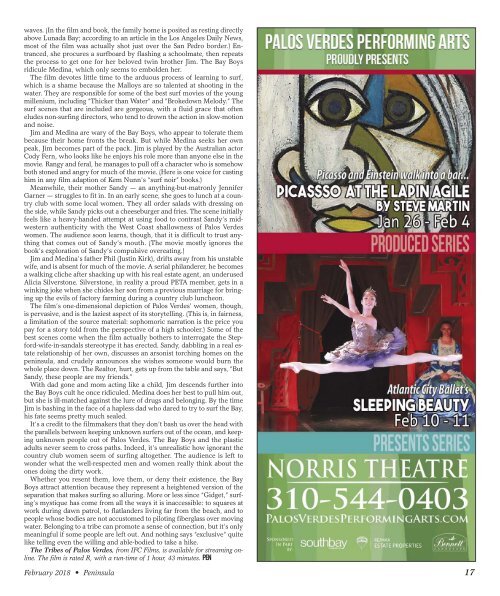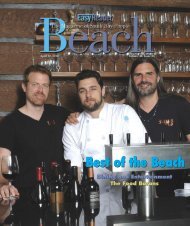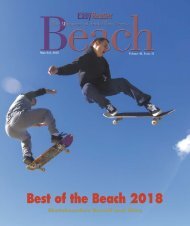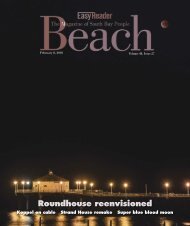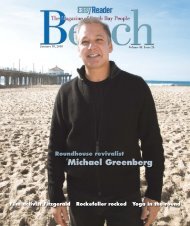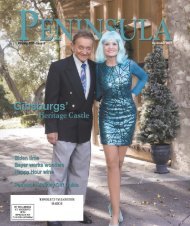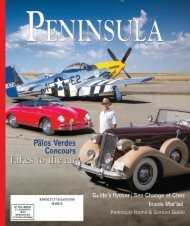Peninsula People Feb 2018
You also want an ePaper? Increase the reach of your titles
YUMPU automatically turns print PDFs into web optimized ePapers that Google loves.
waves. (In the film and book, the family home is posited as resting directly<br />
above Lunada Bay; according to an article in the Los Angeles Daily News,<br />
most of the film was actually shot just over the San Pedro border.) Entranced,<br />
she procures a surfboard by flashing a schoolmate, then repeats<br />
the process to get one for her beloved twin brother Jim. The Bay Boys<br />
ridicule Medina, which only seems to embolden her.<br />
The film devotes little time to the arduous process of learning to surf,<br />
which is a shame because the Malloys are so talented at shooting in the<br />
water. They are responsible for some of the best surf movies of the young<br />
millenium, including “Thicker than Water” and “Brokedown Melody.” The<br />
surf scenes that are included are gorgeous, with a fluid grace that often<br />
eludes non-surfing directors, who tend to drown the action in slow-motion<br />
and noise.<br />
Jim and Medina are wary of the Bay Boys, who appear to tolerate them<br />
because their home fronts the break. But while Medina seeks her own<br />
peak, Jim becomes part of the pack. Jim is played by the Australian actor<br />
Cody Fern, who looks like he enjoys his role more than anyone else in the<br />
movie. Rangy and feral, he manages to pull off a character who is somehow<br />
both stoned and angry for much of the movie. (Here is one voice for casting<br />
him in any film adaption of Kem Nunn’s “surf noir” books.)<br />
Meanwhile, their mother Sandy — an anything-but-matronly Jennifer<br />
Garner — struggles to fit in. In an early scene, she goes to lunch at a country<br />
club with some local women. They all order salads with dressing on<br />
the side, while Sandy picks out a cheeseburger and fries. The scene initially<br />
feels like a heavy-handed attempt at using food to contrast Sandy’s midwestern<br />
authenticity with the West Coast shallowness of Palos Verdes<br />
women. The audience soon learns, though, that it is difficult to trust anything<br />
that comes out of Sandy’s mouth. (The movie mostly ignores the<br />
book’s exploration of Sandy’s compulsive overeating.)<br />
Jim and Medina’s father Phil (Justin Kirk), drifts away from his unstable<br />
wife, and is absent for much of the movie. A serial philanderer, he becomes<br />
a walking cliche after shacking up with his real estate agent, an underused<br />
Alicia Silverstone. Silverstone, in reality a proud PETA member, gets in a<br />
winking joke when she chides her son from a previous marriage for bringing<br />
up the evils of factory farming during a country club luncheon.<br />
The film’s one-dimensional depiction of Palos Verdes’ women, though,<br />
is pervasive, and is the laziest aspect of its storytelling. (This is, in fairness,<br />
a limitation of the source material: sophomoric narration is the price you<br />
pay for a story told from the perspective of a high schooler.) Some of the<br />
best scenes come when the film actually bothers to interrogate the Stepford-wife-in-sandals<br />
stereotype it has erected. Sandy, dabbling in a real estate<br />
relationship of her own, discusses an arsonist torching homes on the<br />
peninsula, and crudely announces she wishes someone would burn the<br />
whole place down. The Realtor, hurt, gets up from the table and says, “But<br />
Sandy, these people are my friends.”<br />
With dad gone and mom acting like a child, Jim descends further into<br />
the Bay Boys cult he once ridiculed. Medina does her best to pull him out,<br />
but she is ill-matched against the lure of drugs and belonging. By the time<br />
Jim is bashing in the face of a hapless dad who dared to try to surf the Bay,<br />
his fate seems pretty much sealed.<br />
It’s a credit to the filmmakers that they don’t bash us over the head with<br />
the parallels between keeping unknown surfers out of the ocean, and keeping<br />
unknown people out of Palos Verdes. The Bay Boys and the plastic<br />
adults never seem to cross paths. Indeed, it’s unrealistic how ignorant the<br />
country club women seem of surfing altogether. The audience is left to<br />
wonder what the well-respected men and women really think about the<br />
ones doing the dirty work.<br />
Whether you resent them, love them, or deny their existence, the Bay<br />
Boys attract attention because they represent a heightened version of the<br />
separation that makes surfing so alluring. More or less since “Gidget,” surfing’s<br />
mystique has come from all the ways it is inaccessible: to squares at<br />
work during dawn patrol, to flatlanders living far from the beach, and to<br />
people whose bodies are not accustomed to piloting fiberglass over moving<br />
water. Belonging to a tribe can promote a sense of connection, but it’s only<br />
meaningful if some people are left out. And nothing says “exclusive” quite<br />
like telling even the willing and able-bodied to take a hike.<br />
The Tribes of Palos Verdes, from IFC Films, is available for streaming online.<br />
The film is rated R, with a run-time of 1 hour, 43 minutes. PEN<br />
<strong>Feb</strong>ruary <strong>2018</strong> • <strong>Peninsula</strong> 17


